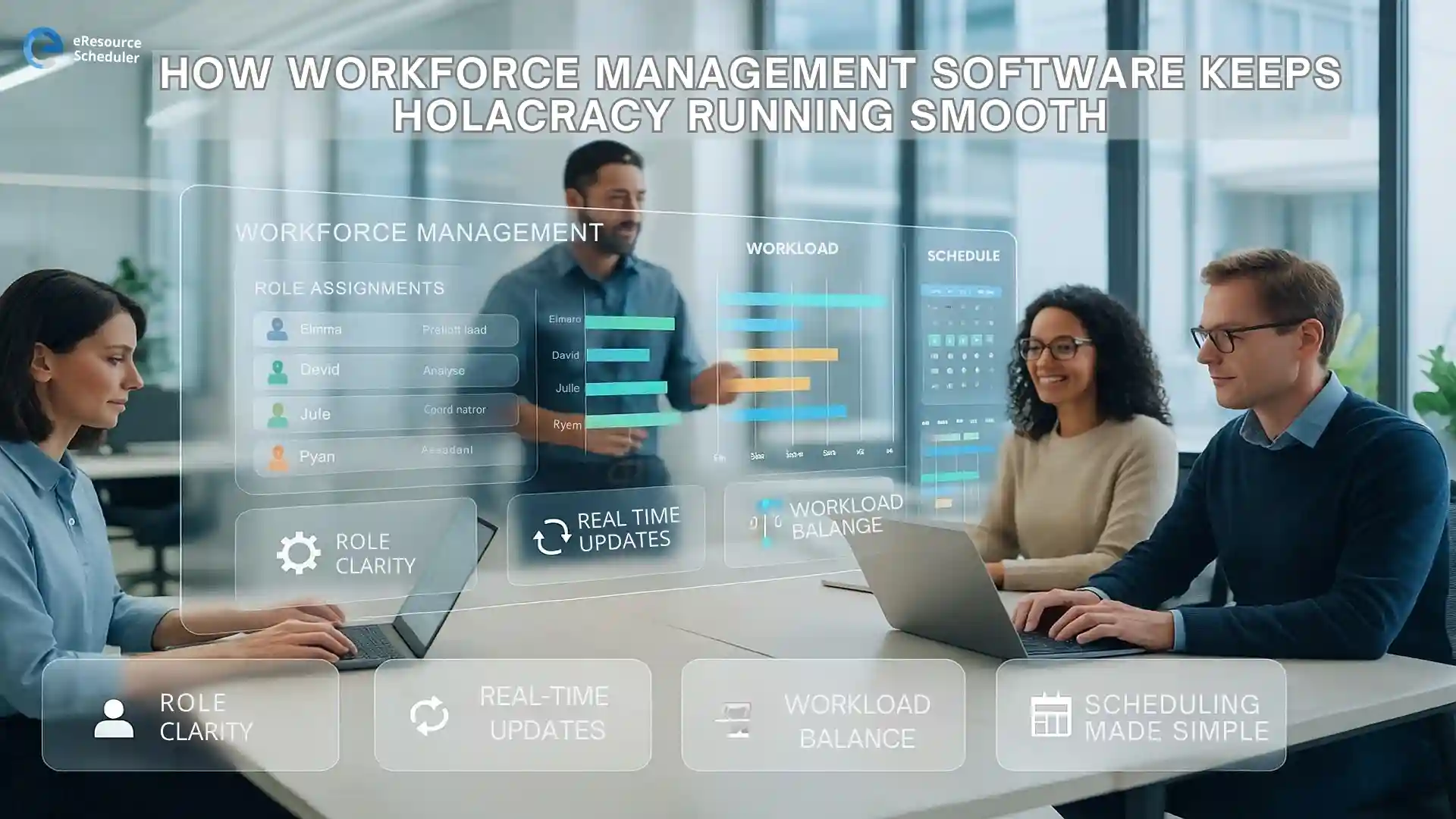
Let’s be honest, the word Holacracy sounds like something cooked up in a Silicon Valley think tank after too much cold brew. But in reality, it’s a bold experiment in how companies can function without traditional managers. No hierarchy. No “reporting to.” Just teams that self-manage, take ownership, and actually get stuff done (most days).
It’s an idea that’s been floating around boardrooms since the 2010s, but as we move into 2026, with hybrid work, flexible schedules, and constantly shifting roles, Holacracy has started getting real attention again. The catch? Without clear systems, “everyone’s in charge” can quickly turn into “no one’s accountable.”
That’s where tools like resource scheduling software come into play. Even the most self-managed setups still need clarity on who’s doing what, when, and how. Otherwise, you’re just running meetings about meetings, and let’s face it, we’ve all been there.
Think of Holacracy as the anti-boss model, but with rules. Instead of managers, there are roles. Instead of titles, there are circles (teams that self-govern). People don’t “report up”; they collaborate sideways.
Each circle handles its own decisions and responsibilities. If something overlaps, circles link through shared roles to stay connected. It’s kind of like a company that runs on Wi-Fi; flexible, adaptive, and constantly syncing in the background.
A few key ideas make Holacracy work:
Sounds dreamy, right? A workplace where bureaucracy takes a backseat and everyone gets a say. But here’s the twist, without proper coordination, it can quickly descend into chaos. Which is exactly why smart companies pair this model with the right digital backbone.
So, how does a team actually function when no one is “the boss”? Imagine a project where everyone knows what needs to be done, but instead of waiting for approval, people just… do it. That’s Holacracy in action.
Each person holds multiple roles instead of one fixed job title. These roles are defined by purpose, accountability, and authority. If something falls under your role, you have the power to make decisions without waiting for anyone’s thumbs-up.
Meetings in Holacracy are different too. They’re shorter, sharper, and built for clarity. People focus on solving issues, not endless updates. The idea is to keep work flowing instead of bottling it up behind “waiting for feedback.”
In many ways, Holacracy is like jazz. Everyone has their part, but there’s freedom to improvise. When done right, it brings creativity and ownership. When done wrong, it turns into noise.
That’s why companies using this model need clear visibility into workloads and timelines. Without some kind of structure, self-managed teams can quickly become self-confused. And that’s where smart tech support steps in.
Even in a flat organization, coordination doesn’t just happen magically. People still need to know who’s doing what, when deadlines hit, and which tasks overlap. That’s where workforce management tools come into the picture.
A good system helps teams plan, track, and adjust on the fly. When every member can see schedules, priorities, and progress in real time, decision-making becomes smoother and accountability clearer.
It’s not about control. It’s about visibility. Think of it as the difference between chaos and choreography. Teams using software to align their work don’t have to rely on memory, Slack pings, or frantic “who’s on it?” messages.
And since Holacracy thrives on transparency, that visibility is priceless. Everyone knows what’s happening across the board, even without a manager watching over.

When your company runs on self-management, you can’t afford to lose track of people or projects. Resource management software keeps the moving parts visible, so teams can make smarter decisions faster.
Here’s how it fits right in:
It’s the secret sauce that turns “self-management” from theory into something that actually works. The beauty of Holacracy lies in autonomy. The beauty of workforce management software lies in keeping that autonomy organized.
Companies that blend Holacracy with technology report more than just fewer meetings. They see faster decisions, higher motivation, and fewer conflicts about priorities.
When everyone has access to shared schedules and workload data, people stop stepping on each other’s toes. They spend less time coordinating and more time creating.
Features like utilization reports also help teams understand where time and effort are going. They highlight capacity gaps, spot inefficiencies, and make sure no one ends up carrying the entire load.
The result is a setup where accountability isn’t enforced, it’s visible. That’s the true power of combining modern structure with flexible leadership.
Holacracy proves that a company doesn’t need layers of managers to function, it needs trust, clarity, and the right digital support system. With smart scheduling and visibility tools, teams can stay aligned without constant check-ins or micromanagement.
The future of work isn’t about hierarchy. It’s about harmony. When people have the freedom to act and the tools to stay in sync, great things happen.
Try a smarter way to coordinate your teams today, book a demo and see how effortless organized freedom can be.
1. What is Holacracy and how does it actually work?
Holacracy is a management system where there are no traditional bosses. Instead, people work in self-managed teams with clearly defined roles and responsibilities. Decisions are made collectively, so everyone has ownership instead of waiting for top-down approvals.
2. Can a company really run without managers?
Yes, but only if there’s structure and clarity. In Holacracy, software and defined roles replace traditional management. It keeps communication transparent and ensures tasks don’t fall through the cracks. Without that framework, self-managed teams can lose direction.
3. What are the main benefits of Holacracy for modern teams?
It encourages accountability, faster decision-making, and higher engagement. People feel trusted to make calls, and because roles are clear, there’s less micromanagement. It also fits today’s hybrid work setups where flexibility is a must.
4. How can technology make Holacracy more effective?
Workforce management tools give teams shared visibility of tasks, deadlines, and responsibilities. Features like utilization reports and scheduling views make it easy to coordinate work and balance workloads, even without managers overseeing everything.
5. What challenges do teams face when switching to Holacracy?
The biggest hurdle is adapting to shared responsibility. Some people struggle without a traditional boss. Others find it hard to prioritize. That’s why most successful Holacratic companies rely on digital tools to guide decisions and track progress.
Plan Smarter. Schedule Faster.
Join thousands already using eResource Scheduler to align teams, time, and tasks seamlessly.